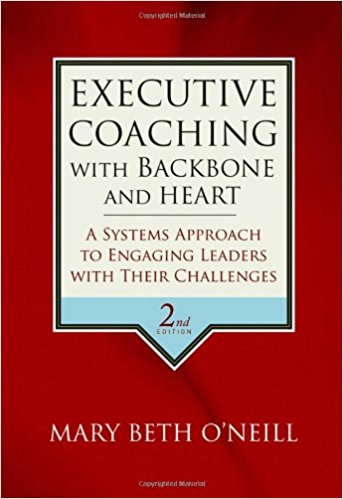Executive Coaching with Backbone and Heart Summary
4 min read ⌚
 A Systems Approach to Engaging Leaders and Their Challenges
A Systems Approach to Engaging Leaders and Their Challenges
To win in any game, you need both a talent and a coach. Mary Beth O’Neill has been the latter to many. And you can learn all about her philosophy in “Executive Coaching with Backbone and Heart.”
These are the best bits!
About Mary Beth O’Neill
Mary Beth O’Neill is an executive coach and a faculty member of the master’s program at the Leadership Institute of Seattle (LIOS). She is the owner of MBO Consulting and a leadership trainer of many Fortune 500 companies, such as “Nike,” “Microsoft” and “Amazon.”
is an executive coach and a faculty member of the master’s program at the Leadership Institute of Seattle (LIOS). She is the owner of MBO Consulting and a leadership trainer of many Fortune 500 companies, such as “Nike,” “Microsoft” and “Amazon.”
“Executive Coaching with Backbone and Heart Summary”
Being an executive coach is not an easy job. Because, it’s not only about knowing everything about leadership, it’s also about knowing everything about people.
And if you’re an executive coach, this may be the only book you’ll ever need to learn the craft.
“Executive Coaching with Backbone and Heart,” as one early review states accurately, “brings form and structure to the art of executive coaching.” It’s an understatement to say that the book is clearly written and neatly organized. At times, it almost reads like an extended PowerPoint presentation!
And that’s a compliment – because, after all, that’s exactly how we store ideas and knowledge! So, let’s copy Mary Beth O’Neill’s methods!
First, the four basics of executive coaching.
And these start with adopting a results-oriented approach. Namely, you need to always focus on a successful outcome. Secondly, you need to become a partner with the executive. Then, you need to get him to explore his or her paradoxical thinking. And finally, you need to understand what’s pulling him/her off course and transform it into specific goals.
And how are you going to do that?
Of course – by employing the three core principles of executive coaching!
First and foremost, you need to bring your signature presence to the table. Be yourself – and be different than the others. Then, you need to be disciplined and constantly have in mind the whole picture.
And, finally, with reference to this systems perspective, you need to start employing O’Neill’s four-part coaching method.
Ready for one last listing?
The first phase of coaching is contracting. This is the phase of building a relationship with the executive you coach. You need to be honest and ask for honesty. You need to see yourself both as a supervisor and as a team member. Listen to what the executive has to say, and notice the discrepancies in his way of thinking. This is, in fact, what you’re needed for.
The second phase of coaching is action planning. It means moving from the general to the particular, from the theoretical to the practical. Focus on the things the executive needs to change both in his or her behavior and in his strategy. Guide the executive to his better self.
The third phase is live-action coaching. This is not always necessary, but it usually works like a charm. It’s the least definable phase since it’s related to every business and it presupposes your continuous day-to-day presence. This way, you can act whenever it is possible. There are three types of live-action coaching: one-on-one leader coaching, coaching the leader in a group setting, and group coaching.
Finally, the fourth phase is debriefing. The essence of the phase is indicated by its name. It includes a final assessment of how your training has helped the executive. But, it won’t hurt if it incorporates his/her assessment of your coaching.
So, you’ll know better the next time you employ this coaching method.
Key Lessons from “Executive Coaching with Backbone and Heart”
1. An Executive Coach Has a Backbone and a Heart
2. Strengthen Your Signature Presence in Four Simple Steps
3. Executive Coaching Has Four Phases – Learn Them Quickly
An Executive Coach Has a Backbone and a Heart
If you want to be an executive coach, you need to be aware that you’ll act both as an overseer and a friend. You need to take care of your backbone to be the former one; and you need to have a good heart to be the latter one.
In other words, you are obliged to have some signature presence and a coaching method. While not forgetting that you have to learn to be a good listener with an even better understanding of the human nature.
Strengthen Your Signature Presence in Four Simple Steps
The reason why you’d go and see any Tarantino or a Wes Anderson movie is fairly simple: you like his style. Well, you need to build yourself one in most professions; and executive coaching is not excluded.
To do this, first you need to identify and maintain a goal. Secondly, you need to stay in control of yourself. Thirdly, you need to react as fast as possible. And finally, you need to express what you feel in your head, and your heart and your guts at all times.
That’s why you’re there, after all.
Executive Coaching Has Four Phases – Learn Them Quickly
The four phases of executive coaching are: contracting, action planning, live-action coaching, and debriefing.
In contracting you’re building a relationship with the executive. If you’re action planning, you’re guiding him or her to the desired goals by looking at the whole picture. In live-action coaching, you stay with the executive as long as necessary and act on a day-to-day basis. Finally, in debriefing, you assess the progress.
And then you repeat everything from the top.
Like this summary? We’d Like to invite you to download our free 12 min app, for more amazing summaries and audiobooks.
“Executive Coaching with Backbone and Heart” Quotes
The essence of executive coaching is helping leaders get unstuck from their dilemmas and assisting them to transfer their learning into results for the organization. Share on X A coach’s job is to have a mission paralleling the leader’s drive for results. Share on X The coaching partnership often begins when the leader is engaged in a dilemma and feels stymied. Share on X The coach links team behaviors to the bottom-line goals, and points out the need for executives to set specific expectations for their teams. Share on X Using a systems perspective keeps you focused on fundamental processes. These forces either promote or impede the interactions and results of the executives you coach. Share on X
Emir is the Head of Marketing at 12min. In his spare time, he loves to meditate and play soccer.


 A Systems Approach to Engaging Leaders and Their Challenges
A Systems Approach to Engaging Leaders and Their Challenges



